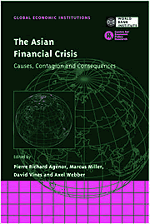Book contents
- Frontmatter
- Contents
- List of figures
- List of tables
- Preface
- List of conference participants
- Acknowledgements
- List of abbreviations and acronyms
- Introduction
- Part One General Accounts
- Part Two Theoretical Contributions
- 5 Capital markets and the instability of open economies
- Discussion
- 6 Volatility and the welfare costs of financial market integration
- Discussion
- 7 A theory of the onset of currency attacks
- Discussion
- Part Three Contagion
- Part Four Policy Responses
- Index
5 - Capital markets and the instability of open economies
from Part Two - Theoretical Contributions
Published online by Cambridge University Press: 26 February 2010
- Frontmatter
- Contents
- List of figures
- List of tables
- Preface
- List of conference participants
- Acknowledgements
- List of abbreviations and acronyms
- Introduction
- Part One General Accounts
- Part Two Theoretical Contributions
- 5 Capital markets and the instability of open economies
- Discussion
- 6 Volatility and the welfare costs of financial market integration
- Discussion
- 7 A theory of the onset of currency attacks
- Discussion
- Part Three Contagion
- Part Four Policy Responses
- Index
Summary
Introduction
The world has in recent months been captivated by the sight of the ‘miracle’ economies of a few months ago tumbling first into a financial crisis and then into a full-scale macroeconomic collapse. Not surprisingly, several potential explanations for why this happened are already in the air: some argue that it was pure happenstance (a ‘panic’); others blame the peculiarities of the financial sector in these economies (‘crony capitalism’).
This chapter takes a somewhat contrarian position with respect to this debate. Specifically it argues that what happened in East and Southeast Asia is not necessarily an aberration requiring a special explanation. In the years before the crisis hit, these economies had been going through a process of rapid change. The financial sector was being liberalised, making it easier for domestic firms to borrow. Partly as a result of this liberalisation, capital was flowing into these economies in large quantities, causing a real currency appreciation, rapid growth in lending and a boom in investment. When the crisis came it is these forces that got reversed – capital flowed out, the currency fell, lending stopped and investment collapsed.
This pattern of a boom accompanied by capital inflows and a real appreciation followed by a dramatic collapse with capital outflows and rapid depreciation is by no means unknown in other middle-income countries. Very much the same thing happened in Mexico in 1994 and in the Southern Cone in the early 1980s.
Perhaps more importantly, this pattern of growth and collapse may be a natural feature of economies at an intermediate level of financial development, especially those with a liberalised financial sector.
- Type
- Chapter
- Information
- The Asian Financial CrisisCauses, Contagion and Consequences, pp. 167 - 190Publisher: Cambridge University PressPrint publication year: 1999
- 26
- Cited by



